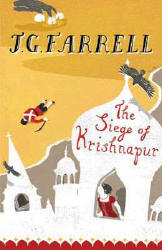Book Review: The Siege of Krishnapur by JG Farrell
WEN reading club meet every month
|
It was the first time that I had been to a book group (You might suggest I needed to get out more often... which is exactly what I did and really enjoyed the night) and I have to say that I would not have ended up reading this title to completion if I hadn't read it with the purpose of sharing it with a group of unknown strangers. (Who I can now confirm were very welcoming, diverse group and good company.)
A word of advice when you arrive at the Drayton is that some of the staff aren't aware that a book group meet there each week but don't be put off - they are there and they meet in a lounge area in the pub; a fitting room to chew the literary fat in.
The novel is an account of the Indian rebellion of British subjects in India during 1857. Based on these events, but fictional in style, this novel was an intriguing mix of satire, parody, the sublime and deliberately ridiculous. Some of us were tempted not to complete the book principally we felt it was at times a slow-moving story that took some time to reach its zenith. Some felt many of the characters came across were initially farcical and pompous.
When the story really shows its flair and starts earning its Booker kudos is when the siege begins. Arguably these privileged and dandy characters reach their most interesting when under duress and siege conditions – and therefore a social observation by Farrell on the complacency and entitlement of the age. These characters come alive and gain substance and interest once given a challenge and purpose – a daring and controversial form of satirical comment from Farrell.
Once the siege begins this is when Farrell was at his best.
What I most enjoyed about the story were the moments that Farrell conveys with such intensity and conviction; the claustrophobia and decay that permeates the very foundations of their community and engulfs Lucy entirely until she becomes a mass of seething black flies - a particularly well conveyed and realised moment in the novel for us all. An omniscient narrator provides some form of social comment or opinion on these characters and this is a challenging element of the siege.
The narrator conveys their misery and wretched end but avoids a moral tale or sense of pathos for the characters created. In this sense Farrell took some risks in exposing these characters; showing no sympathy for the colonialists as the siege tears them apart with carrion, pestilence and decay, we suspect this is representative of how Farrell felt about some aspects of the Victorian existence. We see the Victorians as they suffer and melt in the heat and fury of their trials and sense that Farrell enjoys their fall with gusto.
Farrell’s depiction of the fictional characters and town of Krishnapur also serve as a social comment on the society of the time. Religious fervor turns out to be unfounded or simply feverish, scientific advance is mis-employed and philosophies unfounded or the stuff of pomp and nonsense. Essentially the society is as flimsy as the bookshelves that are devoured by legions of ants in the residency and its occupants are devoured by pests and vermin, famine and disease. The entire story is an extended metaphor for the excess of the age, gluttony so extensive it consumed its very self.
The Siege is a complex story and it’s a tribute to the novel that as I write I find that I could continue endlessly to try to encapsulate the very varied and paradoxical nature of the text. It is comedic, hilarious and implausible - something that would seem to jar with the very bleak content and essence of the story; the siege. It is also a comment on an age, situation and a historical satire. Some remind me of Candide by Voltaire in its satirical and relentless tone. Some of the group noted that elements of Farrell's style provoke comparison to Louis De Bernieres' as he weaves a splendid and hyperbolic story; at the height of the narrative there are moments that are glorious and are testament to the power of Farrell's expression and the sheer quality of his writing.
Read it for the impressive narrative style and characterisation. Stick with it for when the story really gets going; wait for the siege because that is when Farrell's sharpest social observations take place. By the end of the process you come to love these ridiculous characters and in the end ask yourself are we any different or and indeed if our society has progressed any further than theirs. I believe this is what Farrell would have wanted - by examining the society of others we inevitably question the worth of our own with fresh eyes and less presumption - that in itself is a tribute to the book.
Celia Walsh
Next meeting: June 29th: The Pregnant Widow by Martin Amis.
June 16, 2010
